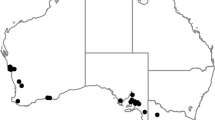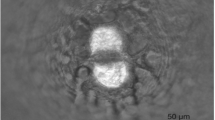Abstract
In response to the recent discovery of Heterodera filipjevi central Henan and the uncertain taxonomic status of Heterodera avenae more widely in China, heteroderid specimens from winter wheat at 21 locations in Henan and adjacent provinces were subjected to RFLP and rDNA-ITS sequence analysis. H. filipjevi was found in six locations in Henan, including two mixed with H. avenae; H. avenae being found at all other locations. A new RFLP profile type was found for H. filipjevi, three new types for H. avenae and the Australian type (Heterodera australis) were found for the first time in China (at two locations). Otherwise, H. avenae and H. filipjevi were of RFLP types previously reported in China. Phylogenic analysis of the rDNA sequences showed H. filipjevi in China was less diverse than H. avenae, with greatest similarity to specimens from Italy and the USA, which is consistent with a more recent introduction. In contrast, H. avenae in China was clearly distinct from H. avenae found elsewhere, except for the discovery of the Australian types. Although the Australian types clustered together, this fell within the variation found for the remainder of the specimens from China, which may represent a single species. These data reveal additional genetic diversity within the two cereal cyst nematode species in China, which is likely to have implications for the development of their control by host resistance.




Similar content being viewed by others
Notes
Peng et al. (2010) report four rDNA-ITS sequences for H. filipjevi from four locations in China. However, only two of the Genbank codes provided are ITS sequences and both are from the same location as our XCXC. These differ by only two to three base pairs from our sequence, so were not included in the phylogenic analysis.
References
Godwin ID, Aitken EAB, Smith LW (1997) Application of inter simple sequence repeat (ISSR) markers to plant genetics. Electrophoresis 18:1524–1528
Handoo ZA (2002) A key and compendium to species of the Heterodera avenae Group (Nematoda: Heteroderidae). J Nematology 34:250–262
Jin SB, Liu DA eds (1964) [‘Flora of Chinese Wheat Varieties’]. Agricultural Publishing House, Beijing, China. pp. 560. [in Chinese]
Li HL, Yuan HX, Sun JW, Fu B, Nian GL, Hou XS, Xing XP, Sun BJ (2010) First record of the cereal cyst nematode Heterodera filipjevi in China. Plant Dis 94:1505
Maafi ZT, Subbotin SA, Moens M (2003) Molecular identification of cyst-forming nematodes (Heteroderidae) from Iran and a phylogeny based on ITS-rDNA sequences. Nematology 5:99–111
Madani M, Vovlas N, Castillo P, Subbotin SA, Moens M (2004) Molecular characterization of cyst nematode species (Heterodera spp.) from the Mediterranean Basin using RFLPs and sequences of ITS-rDNA. J Phytopathol 152:229–234
Nicol JM, Ogbonnaya F, Singh AK, Bishnoi SP, Kanwar RS, Li HL, Chen SL, Peng DL, Bolat N, Şahin E, Elekçioğlu IH (2009) Current global knowledge of the usability of cereal cyst nematode resistant bread wheat germplasm through international germplasm exchange and evaluation. In: Riley IT, Nicol JM, Dababat AA (eds) Cereal cyst nematodes: status, research and outlook. CIMMYT, Ankara, pp 149–153
Nicol JM, Rivoal R (2008) Global knowledge and its application for the integrated control and management of nematodes of wheat. In: Ciancio A, Mukerji KG (eds) ‘Integrated management and biocontrol of vegetable and grain crops nematodes’. Springer, Dordrecht, The Netherlands, pp 251–294
Ou SQ, Peng DL, Li Y (2008) Restriction fragment length polymorphism and sequences analysis of rDNA-ITS region of cereal cyst nematode (Heterodera avenae) on wheat from Zhengzhou. Acta Phytopathologica Sin 38:407–413 [in Chinese]
Peng DL, Ye WX, Peng H, Gu XC (2010) First report of the cyst nematode (Heterodera filipjevi) on wheat in Henan Province, China. Plant Dis 94:1262
Riley IT, McKay AC (2009) Cereal cyst nematode in Australia: biography of a biological invader. In: Riley IT, Nicol JM, Dababat AA (eds) Cereal cyst nematodes: status, research and outlook. CIMMYT, Ankara, pp 23–28
Rivoal R, Valette S, Bekal S, Gauthier J, Yahyaoui A (2003) Genetic and phenotypic diversity in the graminaceous cyst nematode complex, inferred from PCR-RFLP of ribosomal DNA and morphometric analysis. Eur J Plant Pathol 109:227–241
Smiley RW, Yan GP, Handoo ZA (2008) First record of the cyst nematode Heterodera filipjevi on wheat in Oregon. Plant Dis 92:1136
Subbotin SA, Waeyenberge L, Molokanova IA, Moens M (1999) Identification of Heterodera avenae group species by morphometrics and rDNA-RFLPs. Nematology 1:195–207
Subbotin SA, Waeyenberge L, Moens M (2000) Identification of cyst forming nematodes of the genus Heterodera (Nematoda: Heteroderidae) based on the ribosomal DNA-RFLP. Nematology 2:153–164
Subbotin SA, Sturhan D, Rumpenhorst HJ, Moens M (2002) Description of the Australian cereal cyst nematode Heterodera australis sp. n. (Tylenchida: Heteroderidae). Russ J Nematology 10:139–148
Subbotin SA, Sturhan D, Rumpenhorst HJ, Moens M (2003) Molecular and morphological characterization of the Heterodera avenae species complex (Tylenchida: Heteroderidae). Nematology 5:515–538
Vanstone VA, Hollaway GJ, Stirling GR (2008) Managing nematode pests in the southern and western regions of the Australian cereal industry: continuing progress in a challenging environment. Australas Plant Pathol 37:220–234
Yan GP, Smiley RW (2010) Distinguishing Heterodera filipjevi and H. avenae using polymerase chain reaction-restriction fragment length polymorphism and cyst morphology. Phytopathology 100:216–224
Yuan HX, Sun JW, Yang WX, Xing XP, Wang ZY, Riley IT, Li HL (2010) New pathotypes of Heterodera avenae (cereal cyst nematode) from winter wheat in Zhengzhou, Henan, China. Australas Plant Pathol 39:107–111
Zheng JW, Subbotin WL, Moens M (2000) Molecular characterization of Chinese Heterodera glycines and H. avenae populations based on RFLPs and sequences of rDNA-ITS regions. Russ J Nematology 8:109–113
Acknowledgements
Funding was provided by The Special Research and Development Fund for Public Benefit Agriculture (No.200903040) and NSFC-CIMMYT Major International Cooperation Project (No.30921140411). Colleagues from adjacent provinces are thanked for the provision of samples and advice on infested locations, including Chen Shulong (Institute for Plant Protection, Hebei Academy of Agriculture and Forestry Sciences), Wu Huiping (College of Plant Protection, Anhui Agricultural University) and Xiao Yannong (College of Plant Science, Huazhong Agricultural University).
Author information
Authors and Affiliations
Corresponding author
Rights and permissions
About this article
Cite this article
Fu, B., Yuan, Hx., Zhang, Y. et al. Molecular characterisation of cereal cyst nematodes in winter wheat on the Huang-Huai floodplain of China using RFLP and rDNA-ITS sequence analyses. Australasian Plant Pathol. 40, 277–285 (2011). https://doi.org/10.1007/s13313-011-0043-0
Received:
Accepted:
Published:
Issue Date:
DOI: https://doi.org/10.1007/s13313-011-0043-0




